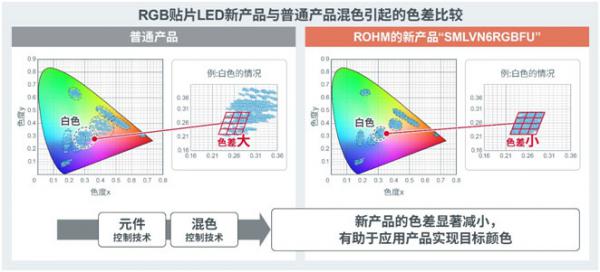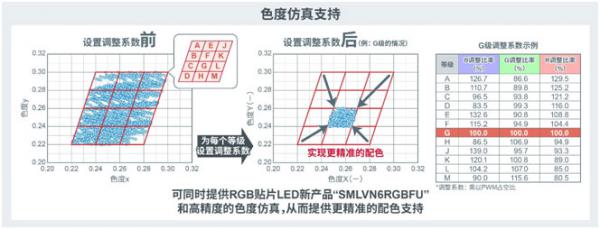ROHM has developed RGB patch LEDs for automotive interiors to reduce color differences caused by color mixing
Time:2023-11-06
Views:504
~Helps achieve the target color of indicator lights and decorative lighting for interior function and status display~




The globally renowned semiconductor manufacturer ROHM (headquartered in Kyoto, Japan) has launched an RGB patch LED * 1 "SMLVN6RGBFU" for automotive interiors, which is very suitable for indicator lights for dashboard and CID (Center Information Display) * 2, as well as decorative lighting applications such as foot lights and door handle lights.

In recent years, with the improvement of automotive electronics and the development of diversified functions, various driving assistance functions such as automatic speed control, distance detection, and lane line detection have been widely applied. In order to display the working status of these functions using indicator lights such as the dashboard, there is an increasing demand in the industry for RGB chip LEDs that can display various colors. In addition, the demand for interior products that use RGB patch LEDs to create a comfortable and luxurious interior space is also increasing. In this context, ROHM utilizes its own component technology to develop RGB chip LEDs with smaller color differences by finely controlling the emission characteristics of RGB components and improving color mixing performance.
Usually, in order for RGB chip LEDs to emit light of the target color, techniques that can accurately control the color and brightness of their red, green, and blue (RGB) emitting components, as well as techniques that can improve color mixing performance, are required. ROHM utilizes its consistent production system that integrates advantageous technologies from the component manufacturing stage, successfully suppressing the color difference problem of components, and achieving better color performance than ordinary products. In addition, through the color mixing control technology of components, the color difference that is prone to occur during RGB chip LED color mixing is reduced, which helps to achieve the desired color for automotive interiors and other purposes. In addition, ROHM also utilizes a colorimetric simulation system that matches the required specifications to provide fine color matching support.

The new product has been temporarily put into mass production with a monthly production capacity of 300000 units starting from February 2023 (sample price: 500 yen/unit, excluding tax). The production base for the early stage process is ROHM Hamamatsu Co., Ltd. (Hamamatsu City, Japan), while the production base for the later stage process is ROHM Semiconductor (China) Co., Ltd. (China). In addition, the new product has been on e-commerce sales since May 2023 and can be purchased from e-commerce platforms such as Ameya360 and Sekorm.
In the future, ROHM will continue to adhere to the concept of "quality first", develop advanced products suitable for the field of automotive lighting, and contribute to creating a comfortable and comfortable interior environment.
<Chromaticity simulation system>
SMLVN6RGBFU sets adjustment coefficients for each color level and provides color matching support closer to the target color. By simultaneously providing new RGB chip LED products and high-precision color simulation, more precise color matching effects can be achieved.

<Product lineup>

Application examples
◇ Indicator lights used to display functions and status: instrument panel, CID, navigation, audio, heater control, etc
◇ Decorative lighting: footlights, ceiling lights, door handle lights, cup holder lights, etc
<E-commerce Sales Information>
Starting sales from May 2023
E-commerce platforms: Ameya360, Sekorm
The new products will also be gradually released on other e-commerce platforms.


Glossary
*1) RGB chip LED
By combining the three primary colors of light - R (Red), G (Green), and B (Blue) - various colors of LEDs can be produced.
*2) CID (Center Information Display)
The LCD display located in the center console of the car cockpit. In recent years, in addition to displaying automotive navigation systems and infotainment systems, CID has also played a role as an operating unit for on-board functions such as air conditioning.
*3) Indicator light
A device that displays the vehicle status for the driver.
About RoHM
Founded in 1958, ROHM began with the production of its main product - resistors. After more than half a century of development, it has become a world-renowned semiconductor manufacturer. Rom‘s corporate philosophy is: "We always prioritize product quality. No matter how difficult we encounter, we will continuously provide a large number of high-quality products to domestic and foreign users, and contribute to the progress and improvement of culture.
Rom‘s production, sales, and research and development network is distributed around the world. The product involves multiple fields, including IC, discrete components, optical components, passive components, power components, modules, etc. In the world electronics industry, Rom‘s numerous high-quality products have been licensed and praised by the market, becoming a leading enterprise in system IC and advanced semiconductor technology.
[Regarding the business development of RoHM in China]
Sales outlet: Initially established in 1974, Rom Semiconductor Hong Kong Limited. Rom Semiconductor (Shanghai) Co., Ltd. was established in 1999, Rom Semiconductor (Shenzhen) Co., Ltd. was established in 2006, and Rom Semiconductor (Beijing) Co., Ltd. was established in 2018. In order to quickly and accurately respond to the requirements of the expanding Chinese market, Rom has established a vertical integration system in China that integrates development, sales, and manufacturing, similar to its headquarters. As a characteristic of Rom, we actively carry out sales activities that are "close to customers" and strive to provide thoughtful services to customers. At present, there are a total of 20 sales outlets in China, including 4 sales companies in Hong Kong, Shanghai, Shenzhen, and Beijing, as well as 16 branches (branches: Dalian, Tianjin, Qingdao, Nanjing, Hefei, Suzhou, Hangzhou, Ningbo, Xi‘an, Wuhan, Dongguan, Guangzhou, Xiamen, Zhuhai, Chongqing, Fuzhou). And, the distribution network is gradually expanding.
Technical Center: We have technical centers and QA centers in Shanghai and Shenzhen, and North China Technical Center in Beijing, providing technical and quality support. The technical center is equipped with development and design support personnel who are proficient in various markets, and can provide comprehensive solutions from software to hardware to provide technical proposals tailored to customer needs. Moreover, when there is a defect in the product, the QA center will respond to the appeal within 24 hours.
Production base: In 1993, production factories were established in Tianjin (Rom Semiconductor (China) Co., Ltd.) and Dalian (Rom Electronics Dalian Co., Ltd.), respectively. We produce diodes, LEDs, laser diodes, LED displays, and optical sensors in Tianjin, and power modules, thermal printing heads, contact image sensors, and optical sensors in Dalian. As the main production base of Roma, we continuously provide high-quality products to both domestic and international markets.
Social contribution: Roma is also committed to strengthening cooperation with numerous research institutions and enterprises both domestically and internationally, and actively promoting research and development activities of industry university research cooperation. In 2006, we signed a joint framework agreement with Tsinghua University to actively engage in the development of advanced technology for electronic components. In 2008, a donation was made to build the "Tsinghua Roma Electronic Engineering Museum" within Tsinghua University, which was completed in April 2011. In 2012, the "Tsinghua Rom Joint Research Center" was established at Tsinghua University, engaged in joint research projects such as optical components, communication broadcasting, biochips, SiC power device applications, non volatile processor chips, sensors and sensor network technology (structural facility health monitoring), artificial intelligence (machine health detection), and so on. In addition to Tsinghua University, Rom has also collaborated with multiple well-known universities in China to achieve fruitful results.
Based on the accumulated technical strength, high quality, and reliability over the years, Rom will establish a solid cooperative relationship with customers through a solid technical support and customer service system that integrates development, production, and sales. As a rooted enterprise in China, Rom will make positive contributions to improving customer product strength, business development, and China‘s energy conservation and environmental protection cause.
|
Disclaimer: This article is transferred from other platforms and does not represent the views and positions of this site. If there is any infringement or objection, please contact us to delete it. thank you! |











